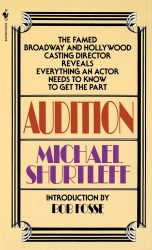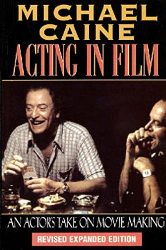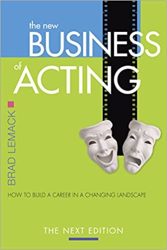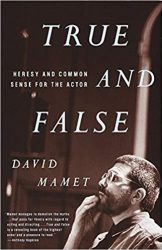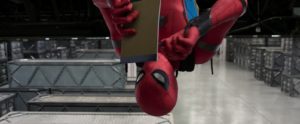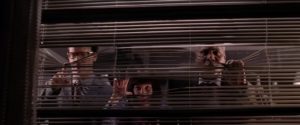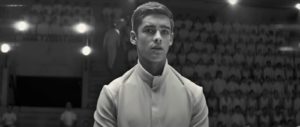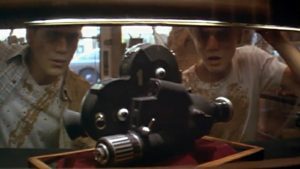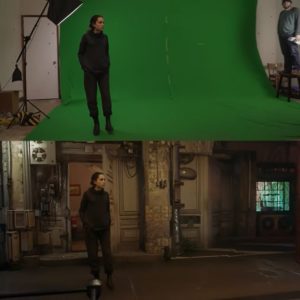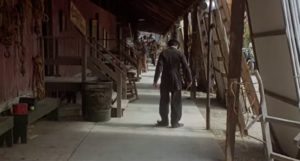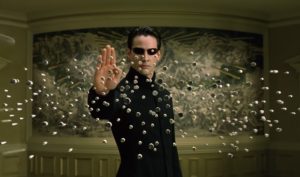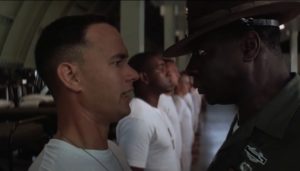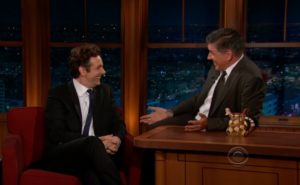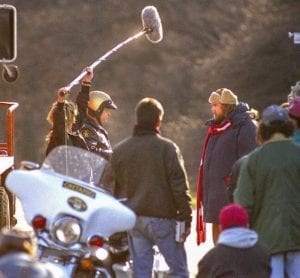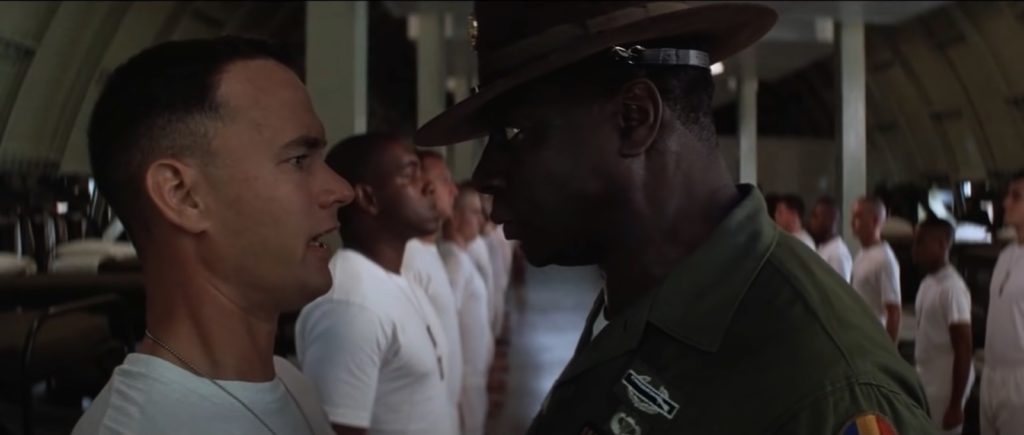
This is what you should do when introducing yourself in an audition or self-tape (i.e. “slating”):
Give the information they ask for in the instructions. For a self tape, you might need to state your name, height, give a full-body shot (camera showing you from head to toe), and say/do something specific to the role (e.g. speak French). If there are no instructions, state your name and the role.
Details, examples, and additional tips/points to consider are given below.
1. Read or listen to the slate instructions.
First of all, know that introducing yourself in an audition or self-tape is called “slating” (and that introduction is called a “slate”).
You will typically get instructions about what information to give for your slate (i.e., introduction). Here is where you can get your slate instructions:
- If you’re auditioning live (in person or virtually), the casting director will typically talk to you before you begin your audition performance and will tell you what information to slate with. Just let them take the lead and you will know what they want from you.
- If you’re doing a self-tape (in other words, making a video recording of your audition at home), look for the slate instructions in the instructions you got in the email about the audition (or in whatever place you found the instructions for the audition). Read those audition instructions carefully and look for the place where they mention the word “slate” – that will be the place where they describe what you need to do for the slate (introduction).
You can find examples of audition instructions (containing slate instructions) if you do a Google search for open call slate site:breakdownservices.com The image below gives an example of such audition instructions, with the slate instructions outlined. You can see that the slate asks for your name, height, location, and experience with stunt performing (or something similar to stunt performing). We’ll go over what “full-body shot” means later.
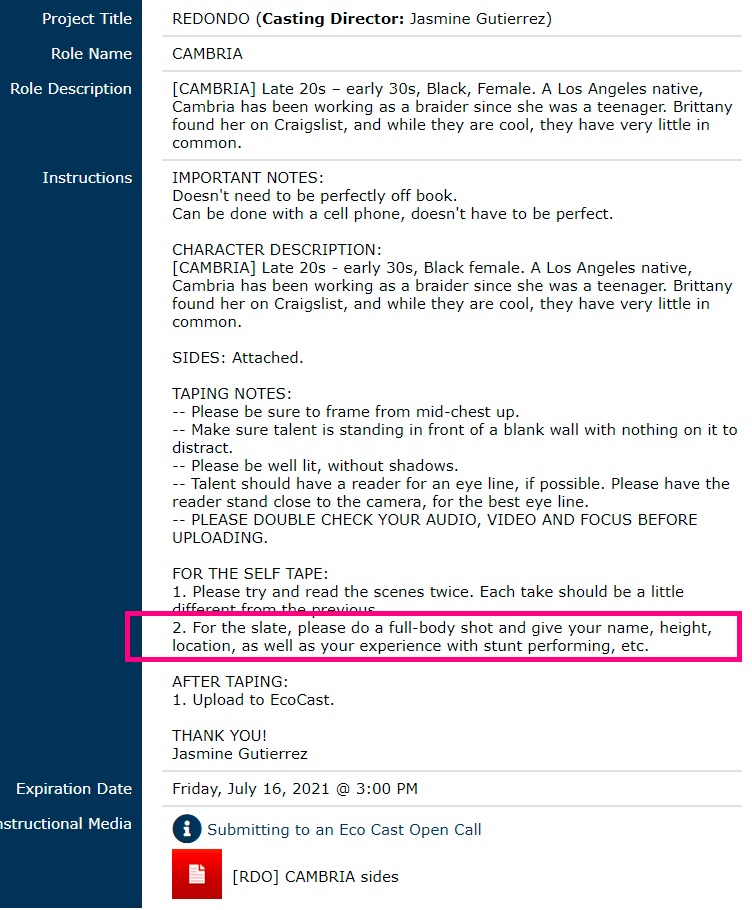
2. Give the information you're asked for.
Once you know what information they want, just say that required information. Here is what they will typically ask you for:
- In many cases, you’ll be asked to slate with your name and height, so you might say something like “Hi, my name is John Smith, and I’m six foot five,” before you begin your audition.
- In lots of independent and student films, people slate with their name and agency (representation). For example. “Hi, my name is John Smith and I’m with XYZ Talent Agency,” or, if you don’t have an agent, you can say, “Hi, my name is John Smith and I’m self-represented.”
- Sometimes you’ll also be asked for additional specific information, such as what city you live in, or they might ask you to do something specific like speak a different language.
In the past, I have been asked to do a slate in Spanish and in English. I’ve also been asked to talk about any tattoos I have and to talk about my opinions on certain things. There is no set rule on what they might ask you, so make sure you read/listen to your slate instructions carefully.
3. If they don’t ask for anything, you can just say your name and the role you’re auditioning for.
Again, in most case you will be told what to do for your slate. However, occasionally, especially in student and independent films, you might not be told what to do for your slate. There are no rules on what to say in these cases, so here are some options:
- Your name and the role you’re auditioning for. For example, “Hi, my name is John Smith, and I’m reading for the role of Walter.”
- Your name and representation. If you don’t have an agent, you can say something like, “Hi, my name is John Smith and I’m self-represented.”
- Your name, height, role, and representation. “Hi, my name is John Smith, I’m six foot five, I’m reading for the role of Walter, and I’m self-represented.”
In a live audition, most of the time in an audition there really isn’t any sort of introduction. Most of the time you’ll just walk in, they’ll say hello, you’ll say hello back, and then they’ll ask you if you have any questions. The reason there tends to not be much of an introduction in a live audition is because, by the time you walk into the room, the casting director has seen your picture, read your resume, and had someone call your agent. From their perspective, they’ve sort of met you. (That’s not to say that every single cast director will just say hello. Some of them will talk a little bit beforehand, others will be very business-like but, in general, you want to avoid talking too much before you perform. More on that later.)
4. Give the required camera shots (profiles, full body).
Sometimes, particularly when you’re doing a self-tape, your slate instructions might mention “full body” or “profiles”. (If you don’t see “full body” or “profiles” mentioned in the instructions, you can ignore this part.)
“Profiles” means they need you to turn to the left and to the right so they can see what you look like from the sides.
“Full body” means they want to see your whole body (head to toe). Note: they only want to see your whole body in your slate – not the whole audition. During your acting performance part, you need to be close to the camera so they can see your facial expressions. (There will be examples of this in the next section.) If you’re doing a self-tape, you might need to use a video editing software to splice together your full-body clip with your close-up clip.
When you’re self-taping, there are multiple ways you can go about getting your full body into the shot. Here are some techniques:
- Zooming in and out with your camera.
- Moving your tripod with the camera closer or farther away from you.
- Having your camera be vertical for the full body shot part and then horizontal for your performance (some advise against this method). If you’re more savvy with video editing software, something you can do is create a split-screen effect for your slate, where one half of the screen is the vertical full-body shot and the other half is a mid-body shot where they can see you more clearly as you are slating (so that you don’t have a lot of empty space on the sides). Another method, recommended by Reddit user randyvinneau, is to shoot the full body shot vertically and then fill in the sides with a gradient that matches his backdrop and lighting, as in this image: https://i.imgur.com/Rrpu0Lv.jpg.
- Panning (tilting) the camera down and back up to so you can still get all of you on camera just not all at once (some advise against this method because it’s less convenient for the viewer than seeing your whole body all at once).
- Prerecording your full-body shot and then editing that clip into various self-tapes (this is not recommended because, if it looks like your full-body shot was taken on a different day, it might cast doubt over whether your body still looks like that, since body appearance can change over time).
Different casting directors have different preferences for full-body shots in self-tapes. The Casting Directors’ Guild of England and Ireland advises having someone filming you, initially zoomed out to show your whole body, and then zooming in so you can be seen to about 6-7 inches below your shoulders. Then you’d give your information, pause, and then give your performance.
Slate Examples
Example 1: The image below gives an example based on a real commercial audition.
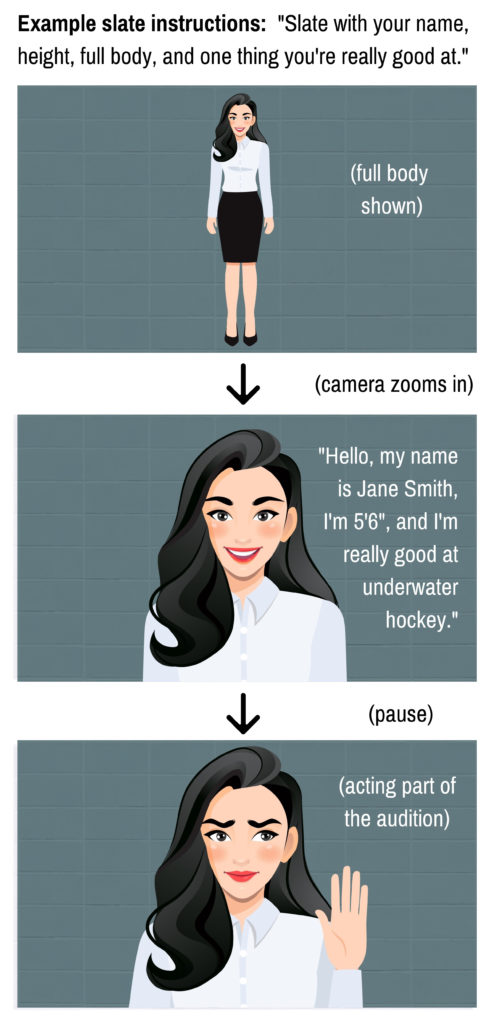
Example 2: In the video below, the actor had been asked to slate with his name, full body, the role he’s auditioning for, his height, and the agency that’s representing him.
Example 3: In the video below, the actress had been asked to slate with her name, her agent’s name, and her height. Notice that this example doesn’t involve a full body shot.
Tips and points to consider
1. Your slate is your first impression, but that doesn’t mean you should slate in character.
As a general rule, here are the best ways to slate for any audition:
- With a hint of the character. For example, if you are playing an aggressive bully, slate with a hint of the aggression, but not full out. If you had slated with a huge smile and being very friendly it, that might contrast so much from what they want that they might stop considering you right then and there.
- Neutral, with just a very quick and deliberate delivery. Think getting a passport picture kind of energy. Simple and straight forward.
- If you’re auditioning for a commercial, slate with a smile.
People start forming an opinion about you as soon as they see you, so some actors prefer to slate in character. Slating in character is risky because the casting director who sees you now might be the same casting director who sees you in some future audition for a completely different role. Slating in character might be helpful in the short term because they might think you’re similar to the character you’re playing so they might think they found the ideal person for the part. However, it could be harmful in the long term because you staying as one consistent character throughout the audition can show a lack of flexibility in your performance so you might get yourself typecast for only these types of roles. It might be better to just show that you’re a pleasure to work with (whatever that means – maybe friendly, maybe efficient, maybe super flexible in performance).
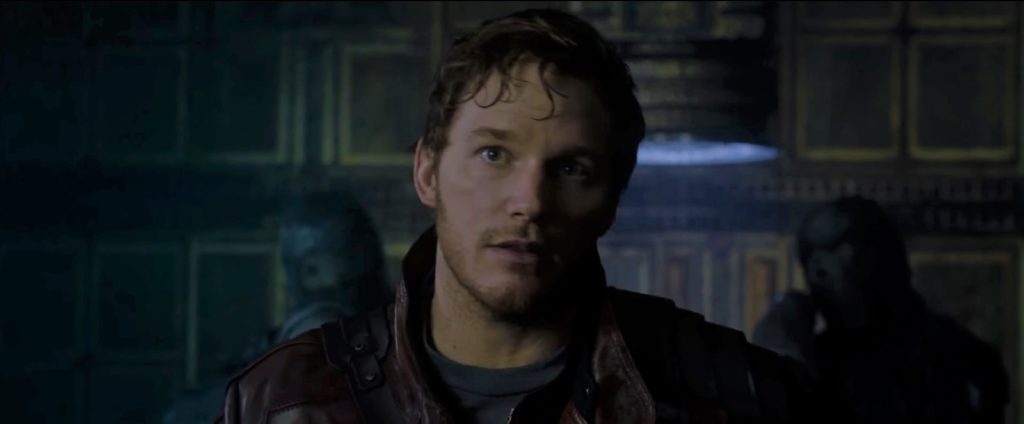
Chris Pratt said, “You walk into the room as the character. You let them think the person you are is close to the character they want. You make them think you already are that guy.” (source) However, you might also notice that, firstly, Chris Pratt tends to play likeable guys (so he’s still showing the casting director that he’s nice to work with even though he’s in character) and the characters he has played have been quite similar to each other.
2. "Tail slate"
If you’re asked to do a “tail slate” for your self-tape, that means they want your slate at the end instead of the beginning. So, just start off your self-tape with your performance and then give your name, height, or whatever information you need to give at the end. Some actors prefer having their slates at the end so that the first impression they give is caused by their performance, not their slate. Some casting directors prefer having the slate at the end to save time (because if they don’t like the performance, then they don’t need the slate information).
3. In a live audition, keep small talk to a minimum.
Let them take the lead. If the casting director or director is very chatty then you can chat with them but if they’re very business-like be business-like. Generally, less small talk is better for the following reasons:
- They’re probably in a hurry. Especially with smaller parts, the casting director is usually under a time crunch, which means they’re trying to see a lot of people in a short amount of time, and they have to submit to the producers quickly. So, if casting directors hardly talk to you, it’s not them being mean or rude, they’re just trying to be as efficient as possible. In those cases, if you try and make small talk and they’re feeling the time pressure this could be counterproductive and put them off.
- Small talk can make you look nervous. People who are too chatty are typically nervous and as a result, you’ll come across as feeling nervous.
- Your performance might suffer. In an audition, the best way to make a good impression is to do good work. Too much small talk socializing can throw you off because it takes your mind off the performance you’re about to give.
The best way to make casting directors like you, the best way to make sure that they always want to call you back, is not by being super friendly. It’s by saying a quick hello, doing good work, and leaving.
To help you with getting reading for the acting part, take a look at the article about how actors read scripts to prepare for auditions and the article about how to prepare for a one line audition.

